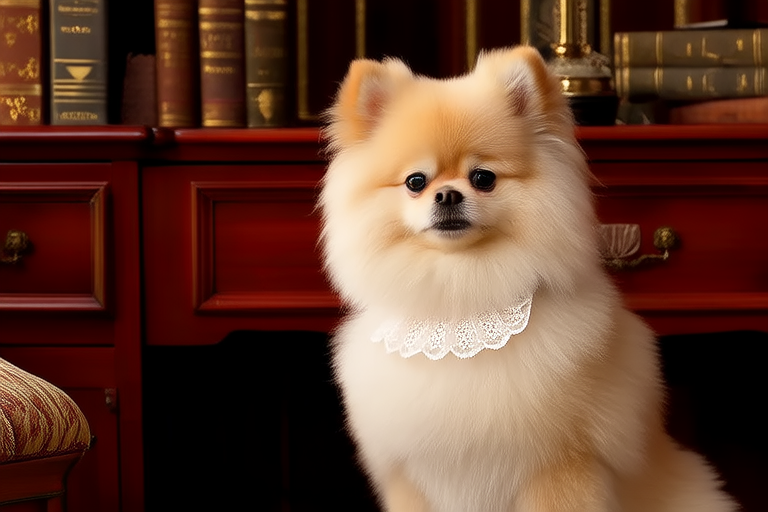The Evolution of Pomeranians: From Sled Dogs to Cherished Companions
The Pomeranian, a breed that has captured the hearts of many, has a rich history that spans centuries. Originating from the region of Pomerania in Central Europe, these dogs were initially much larger and served as sled dogs and herding animals. Over time, through selective breeding, they have transformed into the small, fluffy breed we know today. This article explores the fascinating journey of the Pomeranian, detailing significant historical events, influential figures, cultural roles, and genetic changes that have shaped this beloved breed.
Origins and Early History
The Pomeranian’s lineage can be traced back to the Spitz family of dogs, which includes breeds like the Samoyed and Alaskan Malamute. These early ancestors were robust, medium-sized dogs bred for cold climates, where they worked as sled dogs and herders. Their original size ranged between 20 to 30 pounds, making them suitable for pulling sleds and managing livestock.
The first recorded mention of the Pomeranian dates back to the 16th century, when the breed was brought to England by Queen Charlotte, wife of King George III. However, it was Queen Victoria who played a pivotal role in popularizing the breed. In the mid-19th century, Queen Victoria took a particular liking to the Pomeranian and owned several. Her preference for smaller Pomeranians led to the establishment of the breed standard for the smaller variety, marking the beginning of the breed’s transformation into the toy dog we recognize today.
Selective Breeding and Size Reduction
The process of reducing the Pomeranian’s size began in earnest during the Victorian era. Breeders selectively mated smaller individuals within the breed, aiming to produce dogs that were more compact and suitable as lapdogs. This selective breeding involved careful selection of parents based on desired traits such as size, coat texture, and temperament.
One significant event in the breed’s history occurred at the Westminster Kennel Club Dog Show in 1871, where a Pomeranian named “Dolly” won the Toy Group class. This victory further boosted the breed’s popularity and encouraged more people to participate in breeding programs aimed at refining its appearance and size.
Cultural Roles and Transition to Companion Animals
In addition to their roles as sled dogs and herders, Pomeranians have held various cultural significances throughout history. They have been depicted in art and literature, symbolizing loyalty and affection. For instance, Mozart owned a Pomeranian named Pimperl, and the breed has appeared in numerous paintings by artists such as Frans Hals and William Hogarth.
As the breed became smaller and more manageable, their utility shifted from working roles to that of cherished companions. By the late 19th century, Pomeranians were frequently seen in the company of royalty and aristocracy, further cementing their status as fashionable pets. Today, they are primarily kept as companion animals, appreciated for their playful nature and affectionate demeanor.
Key Characteristics and Genetic Changes
Pomeranians are known for their thick, fluffy coats, which come in a variety of colors, including orange, black, cream, and sable. Their double coat consists of a soft undercoat and a longer, coarser outer coat. This coat provides insulation against cold weather, a trait inherited from their Spitz ancestors.
Genetically, the Pomeranian shares similarities with other Spitz-type breeds but has undergone significant changes due to selective breeding. The breed’s reduced size is attributed to mutations in genes related to growth and development. Specifically, the IGF1 gene, which regulates insulin-like growth factor 1, has been identified as playing a crucial role in determining body size in dogs. Mutations in this gene have been linked to the dwarfism observed in certain breeds, including the Pomeranian.
Another notable genetic characteristic is the breed’s tendency towards certain health issues. Common conditions include luxating patella (dislocation of the kneecap), tracheal collapse, and hypothyroidism. These health problems are often associated with the breed’s small size and specific genetic predispositions.
Enduring Appeal in Modern Society
The enduring appeal of Pomeranians in modern society can be attributed to their unique combination of physical attributes and personality traits. Their compact size makes them ideal for apartment living, while their intelligence and adaptability make them excellent companions for both families and individuals.
Pomeranians are also highly social and thrive on human interaction, making them great therapy dogs. Their small stature and friendly disposition make them suitable for visiting hospitals, nursing homes, and schools, bringing joy and comfort to those in need.
Moreover, the breed’s versatility extends beyond being simply a pet. Pomeranians excel in various canine sports, including obedience trials, agility competitions, and rally obedience. Their quick learning abilities and eagerness to please their owners make them adept competitors in these activities.
In conclusion, the evolution of the Pomeranian from a large sled dog to a diminutive companion animal is a testament to the power of selective breeding and the enduring appeal of these charming creatures. Through the influence of historical figures and significant events, the Pomeranian has become a beloved breed cherished for its loyalty, intelligence, and affection. As we continue to appreciate the Pomeranian’s unique qualities, it is important to remain mindful of the breed’s health concerns and ensure responsible breeding practices to maintain the well-being of these delightful dogs.
